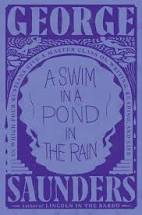
In many ways, George Saunders’ new book, A Swim in a Pond in the Rain: In Which Four Russians Give a Master Class on Writing, Reading, and Life, hits all my buttons. Chief among them is its use of short stories by four Russians — Tolstoy, Chekhov, Turgenev, and Gogol – to illustrate key points on the making and enjoyment of literature. I’ve been reading the Russkies since being knee-high to a praying mantis. Thus, being a Russophile (literary-wise, anyway) and a writer as well, I found myself doing something I seldom do with my books: annotating it as I went along.
Talking to Saunders, is what it amounted to, even though the odds of me ever attending his distant Syracuse writing class lie somewhere between slim and none.
I decided to share a bit here with other readers interested in writing and reading. First, I’ll provide the Saunders remarks that gave rise to some questions and thoughts. Then I’ll offer what I’d say if I were in Saunders class (if my classmates and professor kindy allowed, that is).
For Part 1 of who knows how many, here’s Saunders on one of the simpler “laws” of fiction. You know how laws get one’s ire up. Can you break them? Are they good laws? And what about the caveats, both mentioned and un-?
Saunders:
“Earlier, we asked if there might exist certain ‘laws’ in fiction. Are there things that our reading mind just responds to? Physical descriptions seem to be one such thing. Who knows why? We like hearing our world described. And we like hearing it described specifically (‘Two men in green sweaters were playing catch beside a wrecked car’ is better than ‘I drove through this area that was sort of bland and didn’t notice much.’) A specific description, like a prop in a play, helps us believe more fully in that which is entirely invented. It’s sort of a cheap, or at least easy, authorial trick. If I am trying to put you in a certain (invented) house, I might invoke ‘a large white cat, stretching itself out to what seemed like twice its normal length’ on a couch in that house. If you see the cat, the house becomes real.
“But that’s only part of the move. That cat, having been placed in that particular story, is now, also, a metaphorical cat, in relation to all of the other dozens (hundreds) of metaphorical elements floating around in the story.
“And that cat now has to do some story-specific work. Or, we might say, it’s going to be doing some story-specific work, whether it chooses to or not, by its very presence in the story; the question is what work it’s going to be asked to do and how well it will do it.” (pp. 27-28)
On the surface, there seems little to debate here. Of course a more detailed description makes a scene more believable. The writer’s skill of naming things alone counts for much in his ability to create a sustainable dream for readers.
The catch lies in how much description. It might be “easy,” as Saunders allows, to deploy spellbinding description, but the difficulty lies in when to stop describing. Readers, though they may love description, don’t have infinite patience with it. Ditto editors.
I recall, for instance, my first attempt at a novel umpteen years ago. One editor, kind enough to provide a handwritten response, lauded the description throughout but said there might have been too much (for one) and that it often came at the expense of plot, which she found weak.
Then there’s the famous rule of Chekhov’s gun (rifle, what have you). Once mentioned as hanging on the wall over the hearth, it best be used before story’s end. Which brings us to another tricky concept: which details must play a role in the story and which may not?
A gun is fairly obvious. Why bring it up in passing? But the white cat mentioned by Saunders above? Is it equal to the green sweaters also mentioned above? Almost any detail from a setting can be integrated into a future plot development, but I daresay this will hold true for only a few.
Bottom line: the writer has a problem. Two problems, actually. Yes, your writing is richer through description, but when is enough enough? Salt lends flavor, no one will deny, but too much salt can kill a dish. Put description in a shaker next to pepper, and there you have it.
Additionally, it seems a case of overthinking matters to wonder which objects in any given description must do some “story-specific work,” as Saunders states, merely by dint of their presence. What if the description is implying something about a character, for instance? Does that count, or must it be woven into plot?
All of which brings me back to my own writing precept: Nothing is as simple as it seems. Even if George Saunders calls it a “cheap, or at least easy, authorial trick.”
